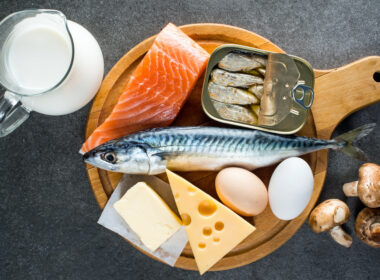It was right smack dab in the middle of our fertile phase.
The kids were in bed.
I had a good day at work.
He had a good day at work.
We were both sipping a nice Oktoberfest, looking longingly at each other—separated by a mere three feet of counter space at the kitchen island.
I let out a long sigh and stated what has become our monthly mantra: “Phase 2 sucks.”
My husband laughed and echoed, “Yeah, Phase 2 abstinence sucks.”
“You know,” I replied, “It’s not really fair. You get more practice than I do.”
“That’s true,” he nodded.
We sipped our beer and sat down on the couch, turning on our regularly-scheduled Phase 2 TV show.
The Struggle Is Real
Earlier this month, Natural Womanhood founder Gerard Migeon featured an article about how men might struggle with abstinence related to NFP, and now we’re here to offer the woman’s perspective as well, because while it is absolutely true that men and women can both struggle with abstinence, we often struggle in different ways.
Take, for example, my observation that my husband gets “more practice” than I do. What does that mean?
One of the biggest challenges for women is the fact that unlike men, our libido is strongly affected by our infradian rhythm: our menstrual cycle. This means that there are natural times when libido is lower or, conversely, when libido may feel totally off-the-charts, through-the-roof!
Admittedly, it would be rather easy to abstain if we only had to do it when our libido was low, right? But practicing NFP means abstaining when a woman’s libido may be surging—and because our libido surges less frequently than that of men, we women just don’t get as many opportunities to practice redirecting our sexual desires when sex isn’t an option.
To further complicate it, the tail end of our luteal phase and the beginning of menstruation is often an uncomfortable time with our bodies in general, and you can see how easily it can feel like NFP is just designed to thwart our happy sex life from the beginning!
So how can couples navigate this frustration together? Is it possible to still have a healthy, satisfying sex life when the woman feels particularly challenged by the rhythms of abstinence when using NFP? There is no magic bullet to solve this problem, but as an NFP Instructor with almost nine years of experience counseling couples (oh—and as a woman, myself!), I’d like to share a few ideas to help us reframe and approach this topic:
1. Your Sexual Desires Are Good!
For many reasons, women tend to fight the notion that libido is a good, healthy, natural part of our sexuality. We forget that the purpose of sex is to aid us not only in biological reproduction but also in bonding with and enjoying our partner.
So when your libido is high and abstinence is really hard: I recommend making an effort to acknowledge it positively. Out loud. It’s perfectly fine and healthy to voice our frustrations by saying something like: “I really wish it weren’t Phase 2, because I totally want to jump you right now.” I guarantee this will elicit at least a smile on his part.
It’s really important that we do not allow ourselves to always hold back on expressing a good desire; and making sure to voice our difficulties gives us the ability to share times of desire and frustration much better as a couple. It keeps us on the same “team.” Studies show that people often bond more strongly over a common enemy than they bond over something positive they have in common. And I believe staying on the same “team” is really crucial to navigating times later in the cycle when the woman’s libido has gone back down.
Unfortunately, low sexual desire is incredibly prevalent for women, and part of this is due to eons of stigma and shame around women’s sexuality that we have internalized. So, if you’re feeling like your libido is in the pits and you’re never interested in sex except when you’re ovulating, do a quick check-in with how you are thinking about sexual desire in general:
- Are you repressing and fighting your libido at any point?
- Do you have negative thoughts about sexual intercourse?
- Do you feel ashamed or embarrassed by the fact that you desire sex?
These are all insidious thoughts that can actually reinforce themselves when your libido has gone back down, resulting in a sex drive that is squashed entirely.
But what can you do instead of repressing your libido? First, you should start rewiring your thoughts and replacing negative ideas with positive scripts, which you can consider saying out loud to your partner during those difficult Phase 2 times as well! Consider something like:
- It is good and healthy for me to desire sex with my husband.
- I am created with the capacity to experience intense pleasure.
- My desires are important in our sexual relationship.
- Sex is designed for both of us to give and receive love in the form of sexual pleasure.
Finally, we would be remiss if we didn’t mention that while it is common and perfectly normal for women to have varying degrees of libido across phases of the menstrual cycle, it is not normal to feel that you have zero interest in sex outside of ovulation. In this case, couples are highly encouraged to see nonexistent libido as a symptom which is worthy of medical investigation and treatment, including therapy and possible lifestyle changes.
2. Up Your Foreplay Game
Abstaining during times of highest libido means that you will likely need to be more intentional about making sure that sexual experiences are positive and fulfilling in times of lower libido. If you tend toward vaginal dryness during infertile times, you can consider lubricants to enhance physical pleasure. You can also be more intentional about focusing on foreplay to awaken responsive sexual desire. We don’t want to fall into stereotypes that men are disinterested in foreplay while women crave it: studies have shown that when it comes to actions immediately preceding intercourse, men and women desire about the same degree of foreplay.
However, it seems incredibly limiting to confine the concept of “foreplay” to a small window of intimacy prior to intercouse. Instead, it may be more helpful to think about “foreplay” as everything which creates an environment for contextual sexual desire. While acronyms like SPICE or the Five Love Languages may seem trite when you’re trying to “substitute” some other type of intimacy for sex, they can be helpful in assessing which areas a couple may want to focus on for creating an atmosphere which allows both of them to feel relaxed, loved, and receptive to sexual intercourse.
Speaking from personal experience: if I’ve had a horrible day at work, the kids were out of control, the kitchen is a total mess, and I’ve got a to-do list a mile long, I am not going to be very interested in sex that night because I will be carrying far too many other stressors and distractions. When couples understand the emotional sources of roadblocks to physical intimacy (including environmental stressors!), or where they might be deficient in other forms of intimacy, they can address those things as part of their foreplay.
3. Don’t Leave Usable Days on the Table
As an instructor, when couples come to me with abstinence concerns I will always gently ask them: are you intentionally not using available days for some reason? Some people think that they need to abstain until Phase 3 if they are “serious” about postponing pregnancy, but efficacy stats are based on using ALL available days per the method. If you’ve chosen to restrict rules beyond the method protocols, it may be creating additional frustrations with abstinence!
Think about this: let’s assume that only using Phase 3 would be 99.9% effective at postponing pregnancy. In our example case, the couple declines to use eight Phase 1 days which would be available to them per method rules. Maybe their method already had a 99% perfect efficacy rate. So the couple needs to think about: is an extra .9% efficacy worth sacrificing a potential ~96 days of available intercourse per year? They might conclude that yes, it is important for them. But they also might decide that it’s more important for their marriage that they not be quite so restrictive in their personal modifications of method protocols.
It’s also possible that couples may misunderstand the protocols and may be abstaining longer than they technically need to. So it’s always a good idea to work with an instructor who can confirm that you understand the rules properly, and may be able to consult with you about trying a different method if the current method seems to yield too few available days.
You’re Not Alone
As with the article presenting the man’s perspective, this merely scratches the surface of dynamics, attitudes, and potential causes or solutions to the all-too-common woman’s struggle with abstinence related to NFP. There is much more to be said particularly about the emotional burden that is sometimes inordinately placed on the woman to ensure that NFP is “successful” in meeting your family planning goals, whether that goal is trying to conceive or trying to postpone pregnancy. This is also a major psychological factor contributing to the couple’s sex life and deserves to be explored on its own.
And we haven’t even touched the question of what to do when a woman’s libido always seems to be higher than her husband’s!
Just know: if you are struggling, you are not alone. Abstinence is a struggle that most of us will face in our NFP journey, but it’s important to always keep in mind the positive things you are preserving in your relationship through giving up sex during the fertile phase. Maybe you are preserving health, or the ability to care for children that you already have. The reasons for postponing pregnancy are myriad and highly individual, but we aren’t abstaining just for the sake of torturing ourselves: it’s for the sake of other goods, which we should reflect on regularly as a couple to help us keep perspective.
If you would like to share your story with our readers (anonymously, if you’d like!), we warmly invite you to do so via this link, so we can continue to hear and respond to real stories about the lived experience of NFP.
References:
- Bullivant SB, Sellergren SA, Stern K, Spencer NA, Jacob S, Mennella JA, McClintock MK. Women’s sexual experience during the menstrual cycle: identification of the sexual phase by noninvasive measurement of luteinizing hormone. J Sex Res. 2004 Feb;41(1):82-93. doi: 10.1080/00224490409552216. PMID: 15216427.
- BOSSON, J., JOHNSON, A., NIEDERHOFFER, K. and SWANN, W., Jr (2006), Interpersonal chemistry through negativity: Bonding by sharing negative attitudes about others. Personal Relationships, 13: 135-150. https://doi.org/10.1111/j.1475-6811.2006.00109.x
- West SL, D’Aloisio AA, Agans RP, Kalsbeek WD, Borisov NN, Thorp JM. Prevalence of low sexual desire and hypoactive sexual desire disorder in a nationally representative sample of US women. Arch Intern Med. 2008 Jul 14;168(13):1441-9. doi: 10.1001/archinte.168.13.1441. PMID: 18625925.
- Woo JS, Brotto LA, Gorzalka BB. The relationship between sex guilt and sexual desire in a community sample of Chinese and Euro-Canadian women. J Sex Res. 2012;49(2-3):290-8. doi: 10.1080/00224499.2010.551792. Epub 2011 May 24. PMID: 21302175.
- Kingsberg SA, Rezaee RL. Hypoactive sexual desire in women. Menopause. 2013 Dec;20(12):1284-300. doi: 10.1097/GME.0000000000000131. PMID: 24219879.
- Clayton AH, Kingsberg SA, Goldstein I. Evaluation and Management of Hypoactive Sexual Desire Disorder. Sex Med. 2018 Jun;6(2):59-74. doi: 10.1016/j.esxm.2018.01.004. Epub 2018 Mar 6. PMID: 29523488; PMCID: PMC5960024.
- Frühauf S, Gerger H, Schmidt HM, Munder T, Barth J. Efficacy of psychological interventions for sexual dysfunction: a systematic review and meta-analysis. Arch Sex Behav. 2013 Aug;42(6):915-33. doi: 10.1007/s10508-012-0062-0. Epub 2013 Apr 5. PMID: 23559141.
- Finley N. Lifestyle Choices Can Augment Female Sexual Well-Being. Am J Lifestyle Med. 2017 Nov 9;12(1):38-41. doi: 10.1177/1559827617740823. PMID: 30283244; PMCID: PMC6125014.
- Miller SA, Byers ES. Actual and desired duration of foreplay and intercourse: discordance and misperceptions within heterosexual couples. J Sex Res. 2004 Aug;41(3):301-9. doi: 10.1080/00224490409552237. PMID: 15497058.
Additional Reading
Men and NFP: When the challenges of periodic abstinence feel unbearable
How to be intimate when you can’t have sex: Advice for the fertile window
How Fertility Awareness Can Help with Healthy Libido







